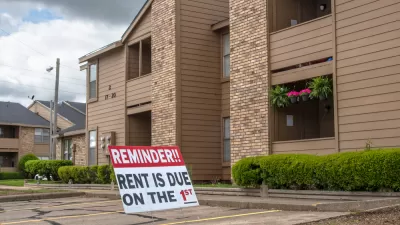The Architecture Billings Index for March 2020 set new standards of collapse.

The Architecture Billings Index (ABI) for March 2020 paints a "dire portrait of the state of architectural services demand," reports Jonathan Hilburg. In more detail:
Whereas the ABI in February 2020 painted a rosy picture of demand at 53.4 (50 is the baseline and represents no change, higher numbers represent an increase and lower numbers a decrease), March billings came in 33.3. This 20.1 swing is, according to the AIA, the largest downturn ever recorded in the ABI’s 25-year history. Even the 2001 recession only pushed demand down by 9.4 points, while the housing crash in 2008 decreased billings by 8.3 points.
According to Hilburg, the March report shouldn't come as a surprise after the special report the AIA released on April 10, but the April report should provide more insight about the depths of the economic downturn expected for the built environment fields.
The construction industry is already reporting large numbers of layoffs, as states like New York and Pennsylvania have halted construction projects. New York City recently ordered a halt to all public design work, and major architecture firms are furloughing employees.
FULL STORY: Architecture Billings Index bottoms out to historic lows

Trump Administration Could Effectively End Housing Voucher Program
Federal officials are eyeing major cuts to the Section 8 program that helps millions of low-income households pay rent.

Planetizen Federal Action Tracker
A weekly monitor of how Trump’s orders and actions are impacting planners and planning in America.

Ken Jennings Launches Transit Web Series
The Jeopardy champ wants you to ride public transit.

‘Minnesota Nice’ Isn’t so Nice When You Can’t Find a Place to Live
The Economic Development and Housing Challenge Program can help address the scourge of homelessness among Indigenous people.

NYC Open Streets Organizers Call for City Support
The number of open streets projects has dropped year after year as volunteer groups struggle to fund and staff them.

Crime Continues to Drop on Philly, San Francisco Transit Systems
SEPTA and BART both saw significant declines in violent crime in the first quarter of 2025.
Urban Design for Planners 1: Software Tools
This six-course series explores essential urban design concepts using open source software and equips planners with the tools they need to participate fully in the urban design process.
Planning for Universal Design
Learn the tools for implementing Universal Design in planning regulations.
Heyer Gruel & Associates PA
Ada County Highway District
Institute for Housing and Urban Development Studies (IHS)
City of Grandview
Harvard GSD Executive Education
Toledo-Lucas County Plan Commissions
Salt Lake City
NYU Wagner Graduate School of Public Service





























